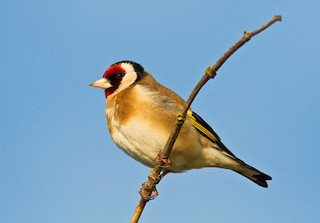 Who doesn’t love a Goldfinch?
Who doesn’t love a Goldfinch?
Photo: © Natural England/Allan Drewitt
Scientific name: Carduelis carduelis
Other common names: European Goldfinch
Cornish name: Melenek
Conservation status: UK Birds of Conservation Concern, Green; IUCN Red List, Least Concern.
What to look for:
- Colouring and appearance: Red face, black cap, jet-black wings with bright yellow patch, white/cream cheeks and chest.
- Size: Length 12 cm, wingspan 24 cm.
- Where: Shrub and patchy woodland, including gardens, parks and heaths. They are more common in the south than the north of the UK. Globally, races of European Goldfinch can be found distributed across Europe, northern Africa and west to central Asia.
- Call: High, liquid notes
- Similar species: Greenfinch, which is a similar size, but easily distinguished by colour.
 Goldfinches are bright, beautiful and sociable, and provide an instant splash of colour round a winter bird table or seed feeder, where they are particularly partial to niger seeds. You might also spot them hanging off a dried teasel or thistle head – they love eating the seeds, which are inaccessible to birds with shorter, thicker bills, and their small size means the slender stem of the plant can easily support them. This behaviour is however only performed by the males: the females have shorter beaks and cannot reach the seeds.
Goldfinches are bright, beautiful and sociable, and provide an instant splash of colour round a winter bird table or seed feeder, where they are particularly partial to niger seeds. You might also spot them hanging off a dried teasel or thistle head – they love eating the seeds, which are inaccessible to birds with shorter, thicker bills, and their small size means the slender stem of the plant can easily support them. This behaviour is however only performed by the males: the females have shorter beaks and cannot reach the seeds.
In spring, the wonderfully liquid song of the Goldfinch rings out from branches as the birds display by drooping their wings and swaying from side to side. They breed in loose groupings, with the females each laying a clutch of up to five eggs. They might raise two to three broods per year. At other times of year they stick together in flocks of up to 100, depending on food availability. Many of the UK birds migrate further south in winter, finding warmer spots in Europe.
Did you know…?
…Goldfinches used to be caged and kept for the beauty of their song.
…Immortalised in music: Vivaldi’s Concerto in D major has a flute imitating the song of the Goldfinch.
More information and references:
Svensson, L., Mullarney, K., Zetterstrom, D.,1986. Collins Bird Guide, second edition (translated by Christie, D., Svensson, L.). HarperCollins, London.
Published: February 2015
Author: Amanda Scott
Photos: © Natural England/Allan Drewitt
